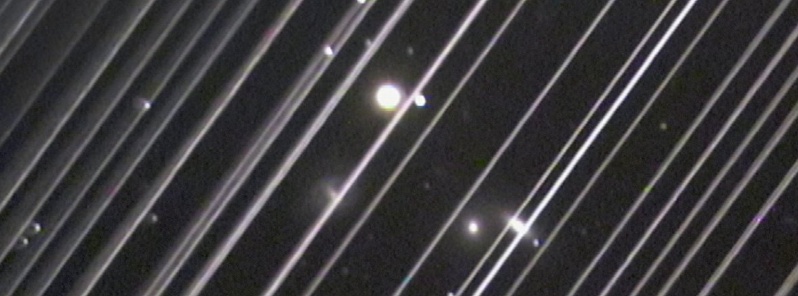International Astronomical Union concerned about satellite constellations

The International Astronomical Union (IAU) has expressed its concern about light pollution posed by an increasing number of satellite constellations in low-Earth orbits (LEO), manly SpaceX's Starlink constellation launched May 23, 2019 – next-generation satellite network capable of connecting the globe with reliable and affordable broadband internet services. The number of low Earth orbit satellites planned to launch in the next half-decade has the potential to fundamentally shift the nature of our experience of the night sky, IAU said.
"The International Astronomical Union, in general, embraces the principle of a dark and radio-quiet sky as not only essential to advancing our understanding of the Universe of which we are a part, but also as a resource for all humanity and for the protection of nocturnal wildlife," IAU said in a statement.
"We do not yet understand the impact of thousands of these visible satellites scattered across the night sky and despite their good intentions, these satellite constellations may threaten both."
"The scientific concerns are twofold," the statement continues.
"Firstly, the surfaces of these satellites are often made of highly reflective metal, and reflections from the Sun in the hours after sunset and before sunrise make them appear as slow-moving dots in the night sky. Although most of these reflections may be so faint that they are hard to pick out with the naked eye, they can be detrimental to the sensitive capabilities of large ground-based astronomical telescopes, including the extreme wide-angle survey telescopes currently under construction.
"Secondly, despite notable efforts to avoid interfering with radio astronomy frequencies, aggregate radio signals emitted from the satellite constellations can still threaten astronomical observations at radio wavelengths. Recent advances in radio astronomy, such as producing the first image of a black hole or understanding more about the formation of planetary systems, were only possible through concerted efforts in safeguarding the radio sky from interference."
"Although significant effort has been put into mitigating the problems with the different satellite constellations, we strongly recommend that all stakeholders in this new and largely unregulated frontier of space utilization work collaboratively to their mutual advantage.
"Satellite constellations can pose a significant or debilitating threat to important existing and future astronomical infrastructures, and we urge their designers and deployers as well as policy-makers to work with the astronomical community in a concerted effort to analyze and understand the impact of satellite constellations. We also urge appropriate agencies to devise a regulatory framework to mitigate or eliminate the detrimental impacts on scientific exploration as soon as practical."
The statement comes 10 days after SpaceX launched their Starlink constellation, a group of sixty satellites into low-Earth orbit.
"Due to their reflective solar panels and other metal surfaces, the satellites are visible to the naked eye at night," the International Dark-Sky Association said. "In the days since they were launched, sightings have been reported all around the world. The visibility of the satellites, combined with a rapid increase in the number of satellites in LEO has caused concern in the astronomy and stargazing communities.
"The rapid increase in the number of satellite groups poses an emerging threat to the natural nighttime environment and our heritage of dark skies, which the International Dark-Sky Association (IDA) has worked to protect since 1988. We do not yet understand the impact of thousands of these visible satellites scattered across the night sky on nocturnal wildlife, human heritage, or our collective ability to study the cosmos."
The U.S. National Radio Astronomy Observatory (NRAO) and the Green Bank Observatory (GBO) have been working directly with SpaceX to jointly analyze and minimize any potential impacts from their proposed Starlink system, NRAO reports.
"These discussions have been fruitful and are providing valuable guidelines that could be considered by other such systems as well. To date, SpaceX has demonstrated their respect for our concerns and their support for astronomy. This includes an agreed-upon protocol to monitor impacts and address issues to NRAO’s current and future cutting-edge research facilities.
"We continue to monitor, analyze, and discuss the evolving parameters of the SpaceX system. Among the many proposals under consideration are defining exclusions zones and other mitigations around the National Science Foundation’s current radio astronomy facilities and the planned future antenna locations for the Next Generation Very Large Array. We also are working with our international partners, including the Square Kilometer Array, to present their concerns as well."
Featured image credit: IAU

Commenting rules and guidelines
We value the thoughts and opinions of our readers and welcome healthy discussions on our website. In order to maintain a respectful and positive community, we ask that all commenters follow these rules.